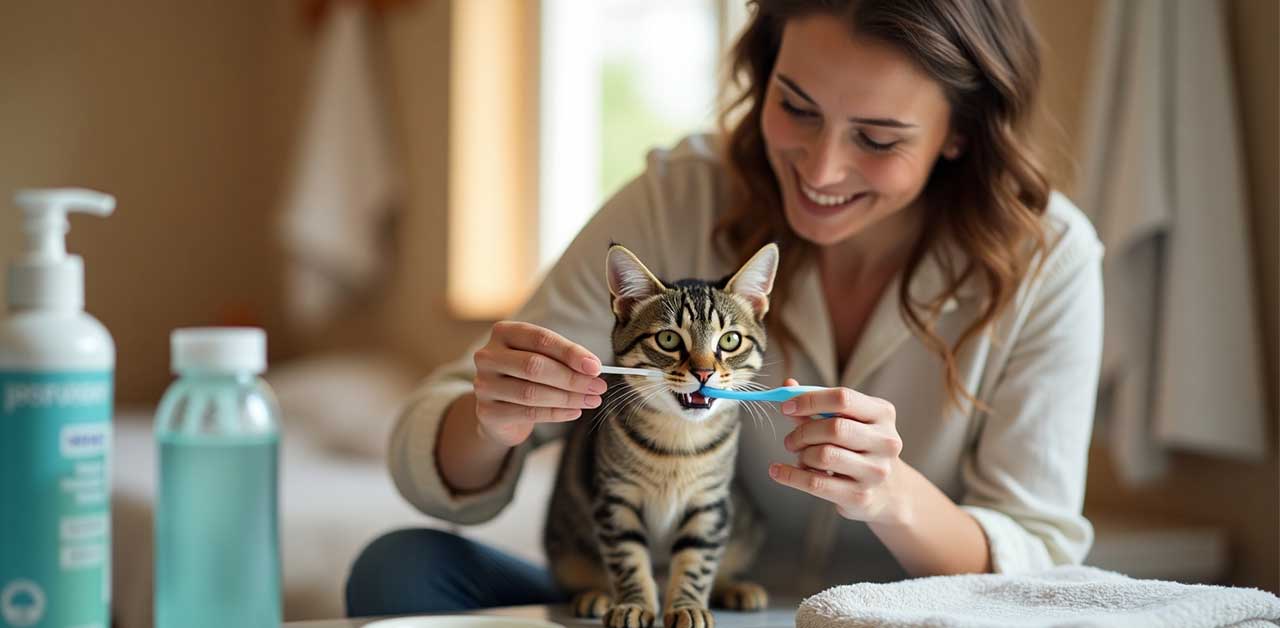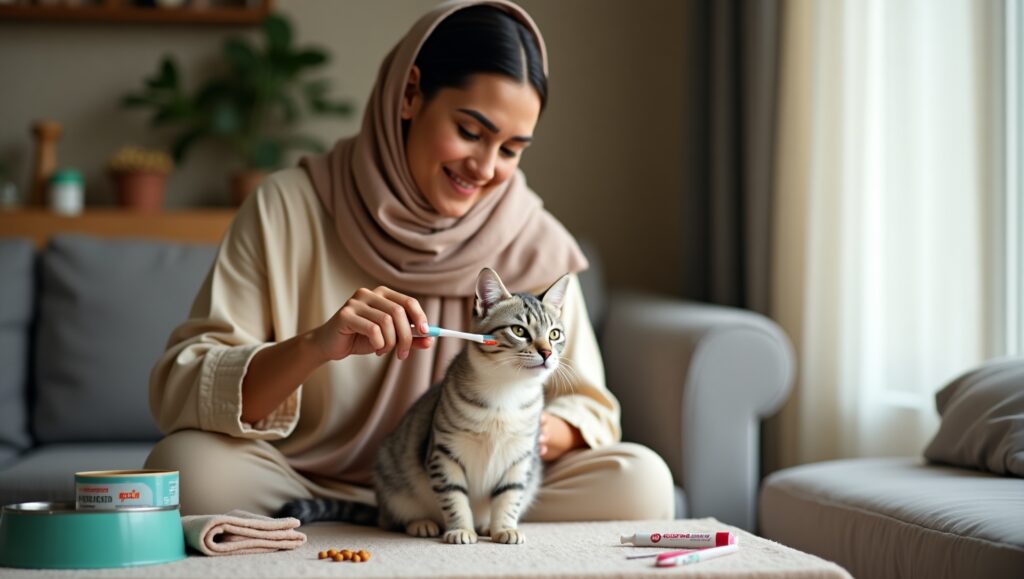How to Brush Your Cats Teeth: A Complete Guide to Feline Dental Care

Brushing your cats teeth isn’t just about freshening their breath — it’s a critical part of maintaining their long-term health. Dental issues in cats are more common than you might think, and ignoring them can lead to more serious health problems like infections, tooth loss, and even kidney or heart disease.
Why Cat Dental Care Matters
Many cat owners underestimate the importance of oral hygiene. Plaque and tartar build-up can sneak up on your pet, and by the time you notice symptoms like bad breath, drooling, or swollen gums, the damage might already be significant. This happened with my own cat, who by age four had developed noticeable dental issues — and it was entirely avoidable.
Just like with humans, prevention is the best strategy. Regular brushing helps reduce plaque and tartar, lowers the risk of gum disease, and contributes to overall well-being. It also strengthens the bond between you and your cat, as daily care routines build trust.
Start Young If You Can
If you’re introducing dental care to a kitten, you’re at a great advantage. Kittens are far more receptive to new experiences and routines. With gentle exposure and consistency, you can establish lifelong dental habits with minimal resistance.
But even adult cats — no matter how stubborn — can learn to tolerate and even accept tooth brushing. It just requires a little patience and strategy.
Introducing Brushing Gently
When I first began brushing my adult cat’s teeth, the experience was far from smooth. He wriggled, avoided me, and clearly disliked any attempt to open his mouth. That’s when I realized I was going too fast.
Here’s the step-by-step approach that worked for me:
-
Get Them Comfortable with Touch
Start by gently stroking your cat’s head, cheeks, and mouth area. Do this for a few seconds each day. Gradually lift the lip so they get used to this sensation. Over time, use your finger to gently rub the outside of their teeth and gums.
This stage isn’t about cleaning — it’s about familiarization. You’re helping your cat feel safe with having their mouth touched.
-
Choose the Right Time
Timing is everything. Choose a moment when your cat is calm and relaxed — often after a meal or during quiet evening hours. Avoid brushing when they’re hyperactive, sleepy, or hungry.
I used a small table to place my cat at a comfortable height. Some cats prefer being in your lap. The goal is to find a position that suits both of you.
Selecting the Right Tools

The right tools can make or break the experience:
- Cat Toothbrush: Use a toothbrush made specifically for cats — they have softer bristles and smaller heads.
- Finger Brush: These fit over your fingertip and offer better control.
- Cat Toothpaste: Choose a flavor your cat enjoys, such as chicken, beef, or fish. Never use human toothpaste — it contains ingredients that are toxic to cats.
I let my cat taste the toothpaste first, without the brush. He happily licked the chicken flavor, and this turned the brushing into more of a treat than a threat.
Step-by-Step Brushing Technique
Once your cat is used to the process and enjoys the toothpaste flavor, it’s time to start brushing.
-
Start Small
Begin by brushing just a few teeth — focus especially on the back molars, where most plaque builds up. Don’t aim to brush every tooth right away.
-
Use Gentle Motions
Gently move the brush in small circles along the outer surfaces of the teeth. If your cat pulls away or shows signs of discomfort, pause and try again the next day. The key is to keep it short and positive.
-
Build Up Gradually
Over several days or weeks, gradually increase the number of teeth you brush. Eventually, aim for a full brushing session, though even a partial one is better than none.
If your cat allows you to brush once a day, that’s ideal. If not, aim for at least 3–4 times a week and supplement with other dental products.
Alternative Dental Aids
Some cats never fully accept brushing — and that’s okay. While brushing is the gold standard, you can use other aids to support your cat’s oral health:
- Dental Chews: Specially formulated to reduce plaque as your cat chews.
- Dental Diets: Dry foods designed to clean teeth while eating.
- Water Additives: Help reduce bacteria in the mouth.
- Oral Sprays or Gels: These can be applied to the teeth or gums, though not all cats tolerate them well.
These aids won’t fully replace brushing but can help maintain oral hygiene when used consistently.
Create a Routine and Stick to It
Routine is everything. Cats thrive on predictability, and the more consistent you are, the more likely they’ll adapt. Choose the same time and place every day. Keep brushing sessions brief — no more than 1–2 minutes.
Break It Down
If brushing all at once is overwhelming for your cat, consider breaking it into parts:
- Day 1: Focus on the left side
- Day 2: Focus on the right side
- Day 3: Front teeth
My vet suggested separating brushing sessions into areas like head, mouth, and gums across different days — especially for older or anxious cats. This made things much smoother.
Reward Your Cat Every Time
Always follow brushing with a reward — whether it’s a favorite treat, toy, or cuddle session. This reinforces a positive association with the routine.
In my case, a couple of salmon-flavored snacks did wonders. Over time, my cat actually started expecting the brush — not out of dread, but curiosity.
Pay Attention to Signs of Trouble
Brushing gives you a great opportunity to spot early warning signs of dental problems:
- Bleeding gums
- Drooling
- Refusal to eat hard food
- Persistent bad breath
- Visible tartar or tooth discoloration
If you notice any of these, schedule a vet appointment immediately. Some issues require professional cleaning or treatment.
Regular Vet Dental Checkups
Even with a great home routine, your cat still needs professional care. Vets recommend annual or bi-annual dental checkups, especially for older cats or breeds prone to dental issues.
Professional cleanings remove deep tartar and address problems you might miss at home.
Don’t Force It
Perhaps the most important rule: Don’t force your cat. If your cat gets scared or defensive, stop immediately. Cats need to feel in control. Forcing the experience can cause long-term fear and resistance.
It’s okay to skip a day. It’s okay to only brush a few teeth. What matters is the long-term pattern, not daily perfection.
Expect Setbacks, Be Patient
Some days won’t go as planned. Your cat might be grumpy, anxious, or simply not in the mood. That’s normal. Like any training, brushing requires patience and flexibility.
If your chosen method or toothpaste flavor isn’t working, switch it up. If your cat refuses the toothbrush, try a finger brush or gauze pad.
Each cat is different — what works for one may not work for another. Keep experimenting until you find your groove.
Benefits Beyond the Mouth
Good dental hygiene improves more than just your cat’s breath:
- Better eating habits
- Fewer health complications
- Improved energy levels
- Happier, more affectionate behavior
I noticed that my cat became more playful and less irritable after just a few weeks of routine brushing. His appetite improved, and he stopped scratching his face and jaw, which I later realized was a symptom of gum discomfort.
Final Thoughts: A Healthier, Happier Cat
Brushing your cat’s teeth may sound like a daunting task at first, but with time, consistency, and the right approach, it becomes second nature — both for you and your cat.
The reward? A cat that’s not only healthier but also more comfortable and content. And fewer vet bills down the road.
Even if you’re just getting started, don’t stress. Start small. Be patient. Make the experience gentle, calm, and rewarding. With each passing day, you’ll be taking a powerful step toward giving your cat a longer, healthier life — one brush at a time.

